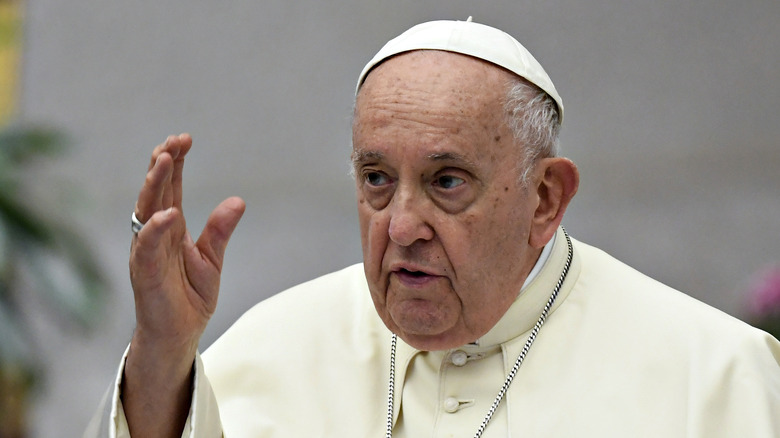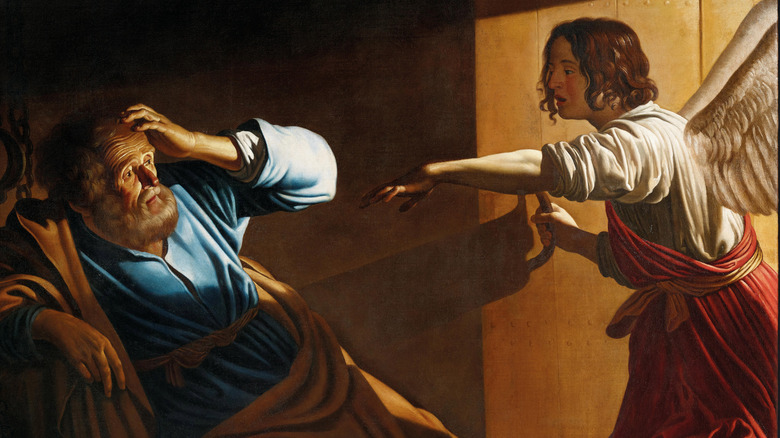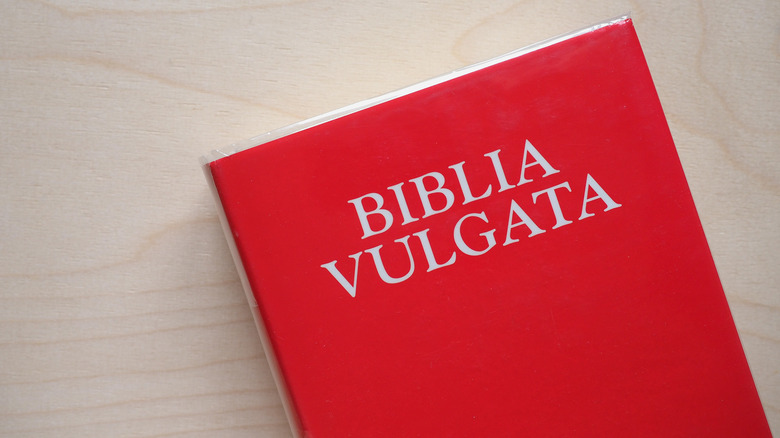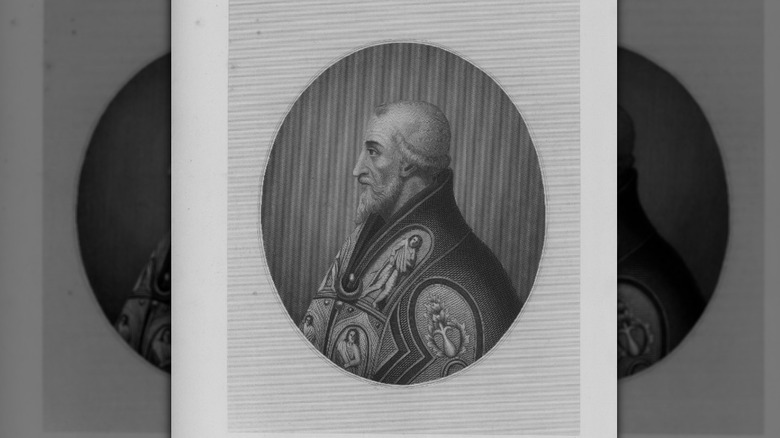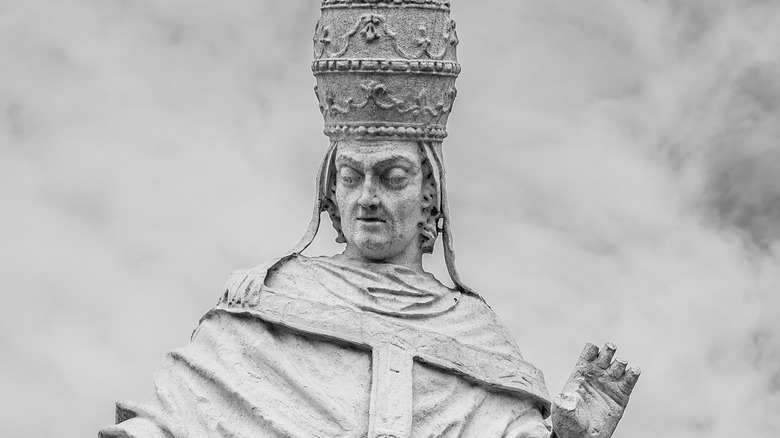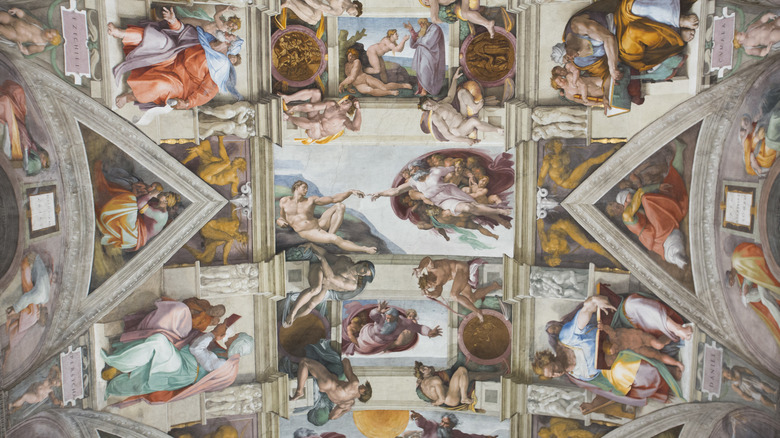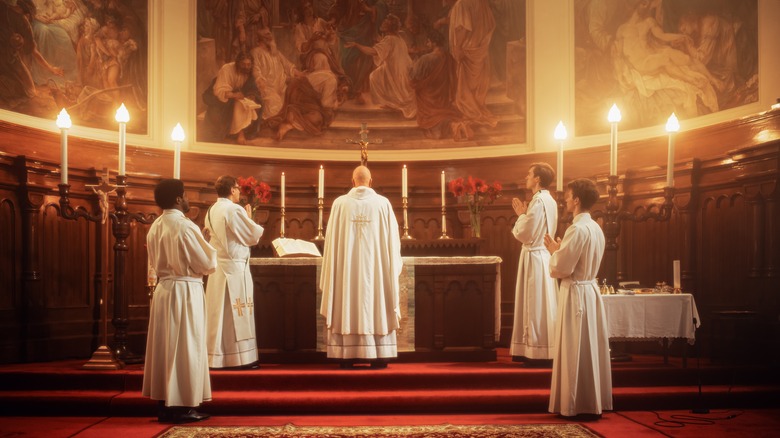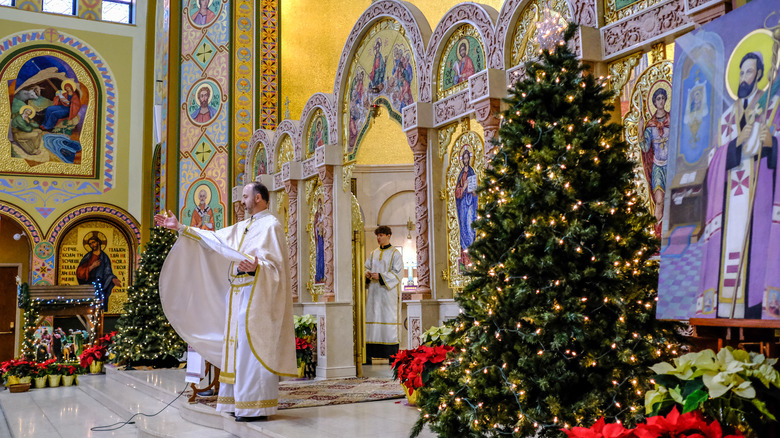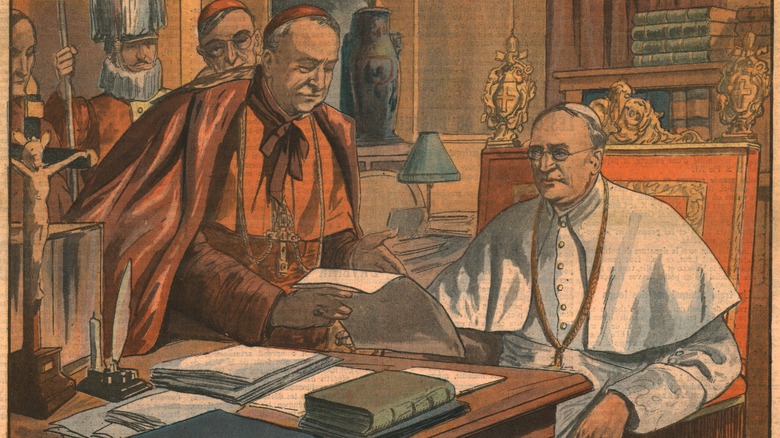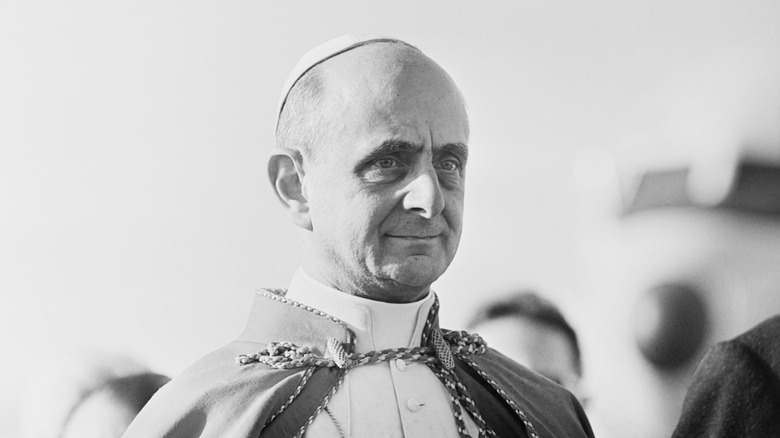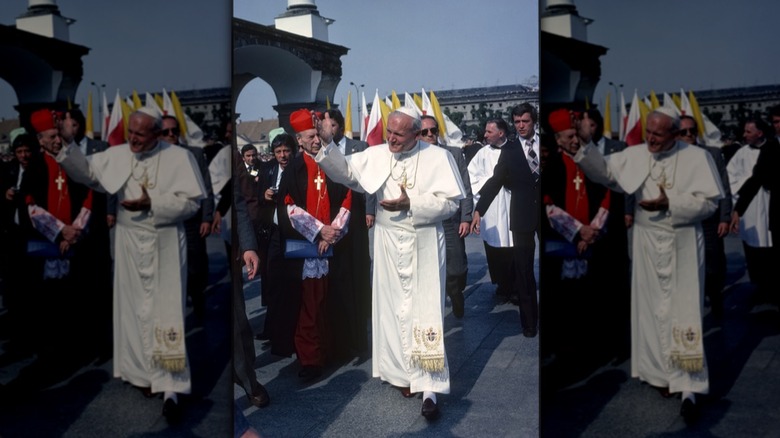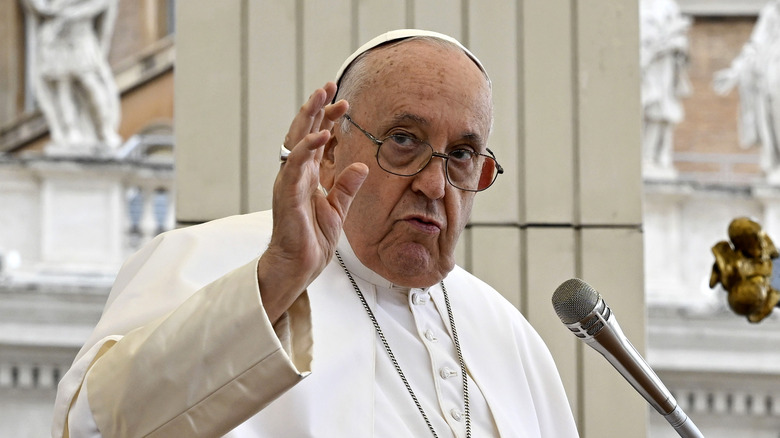Popes Who Changed The Catholic Church Forever
Pope Francis made headlines in October 2023 over claims that the Catholic Church would consider blessing same-sex unions. While these headlines completely distort what Francis actually said, it triggered a debate over whether the Catholic Church can change, how much it can change, and in what ways.
Catholic doctrine has remained pretty consistent throughout the church's 2000-year history, in part because the pope cannot change historic Catholic teaching. But that does not mean the Catholic Church has not changed in other ways, whether aesthetically, linguistically, politically, or liturgically.
Catholic practice and the church itself have evolved over time in response to schisms, heresies, and wars. For instance, when the Ukrainian Catholic Church rejoined Rome in 1596 after splitting from it in the Great Schism of 1054, concessions were made to harmonize their rules with Roman ones. Thus, it might surprise some that the Catholic Church has already had married priests for at least 500 years. Others might be surprised to find that the Mass they attend has only been around since 1970, or that the Church has condemned slavery since at least 1435. Here are some of the biggest changes to the Catholic Church, and the popes who made them.
St. Peter brought the church to Rome
The Catholic Church is based in Vatican City in the middle of Rome, even though it sprang up in the Middle East among Jews after Jesus Christ, per Catholic teaching, founded it. So how did it end up in southern Europe? The Catholic Church owes its place in Rome to St. Peter the Apostle, whose name graces the papal throne and the basilica and square that make up most of Vatican City.
After the Crucifixion, St. Peter became the first pope — that is, the leader of the Universal (aka Catholic) Church. He was not initially based in Rome. He first preached and founded communities in Jerusalem and Antioch. He also ended an early controversy about the status of Jewish Christians (Jews who accepted Christ as the Messiah) and gentile converts. Ultimately, Peter declared that gentiles and Jews would be on equal footing, rather than the traditions of one taking priority over the other.
With that controversy solved, Peter, following Christ's Matthew 28:19 command to go "and make disciples of all nations," eventually reached Rome. There, he served as bishop of Rome and baptized converts in the Tiber. His activities earned him the attention of the emperor Nero, who supposedly had him crucified upside-down. But the Christian community he founded in Rome grew under his successors. Since St. Peter — the leader of the earthly church — died in Rome, his successors stayed there, making the city the seat of the Catholic Church.
Damasus I made Catholicism truly Roman
Pope Damasus I reigned from 366 until his death in 384. His tenure was marked by struggles against Arian heretics, who denied the Christian Trinity as most would recognize it today. But he is also famous for putting the "Roman" in the Catholic Church with his decisions on the Bible and liturgy.
It is generally agreed that Christianity's main language in the Roman Empire was Greek. It was the language of Christian liturgy, prayers, and doctrine, and of most scriptures circulating at the time. Damasus changed that. Among his first orders of business was translating the liturgy and prayers into Latin. This made sense from a practical perspective. The Western half of the Roman Empire, including Italy, was Latin-speaking, making it the ideal language for getting converts and teaching them about their faith. Damasus' legacy in this regard lives on — the official language of the Catholic Church is still Latin.
His greatest contribution, in keeping with his Latinization of Catholicism, was commissioning his secretary, St. Jerome, to produce a Latin Bible translation. The significance of the project was twofold. It was the first time the Old Testament was translated in the West from the original Hebrew sources instead of later Greek versions. Second, it was translated into a Latin that people could understand — hence its Latin name "Editio Vulgata," which means "the common edition." This Bible, known today as the Vulgate, is still considered Western Christendom's most important Bible translation.
Leo IX saw Catholicism fracture into two
Pope Leo IX presided over the beginning of a major fracture in the Catholic Church, although he probably did not mean to — the Great Schism of 1054. Although the schism, which birthed the Orthodox Church as an independent entity, had numerous causes, the immediate one, per CUA Prof. George Dennis writing for the Christian History Institute, was a dispute over the status of Greek-speaking churches in Italy.
Patriarch Michael Cerularius of Constantinople got upset with Leo after he found out that Eastern, Greek-speaking churches were being shuttered in southern Italy. He retaliated by closing Western, Latin-speaking churches in Constantinople. In response, Leo sent Cardinal Humbert de Silva Candida to negotiate. Instead of trying to diffuse the situation, the cardinal picked a fight with Cerularius over finer theological points. After Cerularius ignored the bait, de Silva Candida excommunicated him in the pope's name by placing the notice on the Hagia Sophia Cathedral's altar. The Orthodox Church adds that Cerularius retaliated by excommunicating the cardinal and "all those responsible" — presumably including Pope Leo IX. The only problem was that Leo had died by then and there was no successor in Rome when Cerularius issued his excommunication.
In the end, the two halves of Christendom never fully reconciled, despite numerous attempts to do so in the face of the gradual Muslim Turkish conquest of the Byzantine Empire. According to Philip Mansel's book "Constantinople: City of the World's Desire," once Constantinople fell to the Ottomans in 1453, Sultan Mehmet II appointed anti-Roman Gennadios II as patriarch of the city, finalizing the break between Eastern and Western churches that persists to this day.
Eugene IV denounced slavery
In an interview with NPR, historian Rachel Swarns stated that slavery created the modern Catholic Church. It is not the first such accusation — according to EWTN, one prominent American judge claimed Catholicism only condemned slavery in 1890. But while individual Catholics and institutions engaged in slavery, the church was also among the first to condemn it as an affront to human dignity.
In 1435, Eugene IV issued the encyclical "Sicut Dudum," responding to reports that "some Christians ... with fictitious reasoning and seizing an opportunity ... approached [the Canary Islands]" to enslave the native people who lived there. Some of them, the pope said, were Christians, or were tricked into accepting Catholicism to lure them into enslavement. Eugene ordered the culprits to free the captives immediately and return them home to the Canary Islands within 15 days. Violators were threatened with excommunication.
Although the encyclical was not a complete condemnation, as it only applied to the enslavement of Christians or those who wished to convert, it was part of a long tradition of papal anti-slavery activism. Pope Paul III expanded Eugene's ruling in the 1537 encyclical "Sublimis Deus," which said that no person whom Christians might discover abroad could be enslaved or robbed. Paul III maintained that they were people who wanted to find God and should be "converted to the faith of Jesus Christ" instead. In 1839, Gregory XVI issued the church's definitive condemnation of slavery, although many American clergymen ignored him.
Julius II gave the world Michelangelo
Julius II allowed England's King Henry VIII to marry Catherine of Aragon, sowing the beginnings of the crisis that would turn England Protestant. But his greatest contribution to Catholicism was turning the church into the main patron of Italian Renaissance art. Known to contemporaries as a "patron of genius," according to the UK Catholic Herald, Julius sought out the best artists money could hire to beautify Rome and its churches. Among Julius' greatest finds were Raphael, who painted the reception rooms, also known as the Stanze, of the old papal palace, and Bramante, who designed the church of Santa Maria del Popolo – allegedly built on anti-Christian Roman emperor Nero's grave.
But Julius' greatest find was Michelangelo Buonarroti. It wasn't always the healthiest relationship — the pope allegedly beat the artist with a stick when he refused to show him a work in progress. Nevertheless, the partnership yielded the ceiling of the Sistine Chapel (pictured), which millions visit every year.
Although Julius was not the first pope to patronize art, he took it to another level, putting art at the service of Catholicism at a time when the Church was facing challenges to papal authority — all while beautifying the city of Rome. But it came with a cost. The expensive projects undoubtedly allowed corruption and excess to seep into the Vatican –- one of Martin Luther's major complaints that set off the Protestant Reformation.
Pius V brought about uniformity at Mass
The Catholic Church is known for its uniformity. Everyone attends the same service and recites the Nicene Creed every Sunday, professing a belief in "one, holy, catholic, and apostolic church." But Catholicism's ritual uniformity — the brainchild of Pope Pius V — is relatively recent in the Church's 2000-year history. In 1570, he issued "Quo Primum," which decreed that Catholic priests could only say Mass according to the Tridentine Rite (aka the old Latin Mass) using only books published with Vatican approval, at the expense of other rites.
So what were these other "rites"? Before 1570, the Tridentine Mass co-existed with other ways of saying Mass, such as the Lombard Ambrosian Rite, the Mozarabic Rite in Spain, and the English Sarum Rite. These were all in Latin, but differed from the Tridentine Mass in calendar, readings, and degree of Greek influence. "Quo Primum" threatened to suppress these rites. However, Pius inserted an exception, perhaps remembering that when the papacy had attempted to suppress the Ambrosian Rite in the 15th century, a massive riot had broken out in Milan. If the papacy gave explicit approval and the rite had been practiced for at least 200 years, its usage could continue.
The exception saved the Ambrosian Rite, but most other regional rites fell out of use. The Tridentine Mass became the norm, aided by European colonization, which spread it all over Asia, Africa, and the Americas, making it the standard Catholic Mass until 1970.
Clement VIII got Ukraine back to Rome
Clement VIII's greatest triumph and change to the Catholic Church came in Eastern Europe. In the 16th century, the Orthodox Church in Ukraine and Belarus had fallen on hard times. The Muslim Ottomans had conquered much of the Orthodox world in the Balkans and cut Kiev off from its mother church in Constantinople. Meanwhile, the Catholic Church appeared to be holding the line, despite the Protestant Reformation.
Seeing Rome as a potential solution to their problems, a handful of Orthodox clergy approached Pope Clement VIII and King Sigismund III of Poland and requested to join the Catholic Church. The pope and the king were thrilled. After some haggling, the Polish king accepted the terms, the pope signed off, and the Union of Brest became a reality in 1596.
The union's terms were straightforward. The Orthodox clergy in Ukraine and Belarus would join the Catholic Church under the pope. They would not become Roman, however. Instead, they would enter as a separate "Greek Catholic" church with its own leadership within the greater Catholic Church, on equal footing with the clergy of the Roman Catholic Church. They were allowed to keep the Orthodox Divine Liturgies and other prayers and continue to observe Orthodox rules, including allowing priests to marry. They could also conduct services in their local languages rather than Latin. Today, the union's primary legacy is the Ukrainian Greek Catholic Church, which boasts nearly 5 million members and has survived both Russian imperialism and Soviet liquidation.
Pius XI created Vatican City
Today, Vatican City is a major part of the international community, punching well above its weight as the world's smallest sovereign state. But it is a recent addition, having only come into existence in 1929 thanks to Pope Pius XI.
As Prof. Roberto Regoli of Rome's Pontifical University explained to EWTN, the modern Holy See — the Roman Catholic government based in Vatican City — was the result of a compromise. After 1870 and the Italian abolition of the Papal States, the pope did not have a state of his own. Without its own state, the argument went, the papacy would be subject to interference from secular powers. Seeking to resolve this impasse and restore papal independence, Pope Pius XI struck a deal with Benito Mussolini for a small portion of the old Papal States. The result of their talks was the Lateran Treaty of 1929. Under the provisions, Italy recognized absolute papal sovereignty over St. Peter's Basilica and St. Peter's Square, while placing the pope under the protection of Italian law. The Vatican and its subsidiaries were exempt from all taxes — including on properties outside the borders of the new state.
Pius XI's achievement restored the Church's independence, but he also inadvertently introduced new problems, especially once a 1942 Italian law exempted Vatican investments from taxation. Since the state entered the world of high finance and banking tax-free, institutional corruption at places like the Vatican Bank has been a major concern, as it cannot be audited due to the Vatican's sovereignty.
Paul VI created the Mass most Catholics attend today
Pope Paul VI is responsible for making one of the biggest changes ever to the Catholic Church in 1970 by introducing the Mass most Catholics attend today. After the Second Vatican Council, Pope Paul VI issued a letter in 1969 called "Missale Romanum," which, in a nutshell, jettisoned the Tridentine (aka Latin) Mass for the current form, called the "Novus Ordo."
The pope justified the change, arguing that in the modern world, a simpler Mass would be more accessible to the public, which would also be able to participate more. Pursuant to these goals, the congregation became more involved by reciting the prayers and the responses, whereas in the Latin Mass the congregation is mostly silent. It also became possible to say Mass in local languages, rather than just Latin.
Not everyone supported the changes. In a letter to Pope Paul, Cardinal Alfredo Ottaviani said the new Mass was unrecognizable compared to the old one and risked confusing and alienating Catholics. He also voiced concerns that the Vatican was making the Catholic Church seem more Protestant. In fact, Ottaviani claimed that Protestant ministers had participated in writing parts of the Novus Ordo, which he and his supporters decried as an attempt to make the Church less Catholic in order to make it more accessible to non-Catholics.
John Paul II helped bring down communism
The death of Pope John Paul I brought Polish-born John Paul II to the papal throne in 1978. This pope unleashed the Catholic Church's influence and financial muscle against communism and the Soviet Union. Historian Felix Corley writes that the Polish pope, who had lived under communism, presented a special problem for Moscow, with his election raising "alarm verging on panic at the highest levels" and prompting the Polish government to call an emergency session. They were worried that anti-communist movements in Eastern Europe now had a powerful protector, who could not easily be silenced.
John Paul II visited Poland in 1979, holding Mass in Warsaw before 300,000 people chanting, "We want God!" In his sermon, the pope maintained that the "exclusion of Christ from the history of man [was] an act against man" and that Poland's future depended on returning to its Christian roots. But the Soviet Union insisted that communism was the future. Jesus Christ had no place in this atheistic ideology. Thus the pope's underlying message: Poland did not have to suffer communism. According to John Paul II, Catholicism offered something better if Poles were willing to believe.
In the end, Poland agreed. The pope's visit exposed communism's unpopularity in the country and inspired the anti-communist Solidarity Movement. Under Lech Wałęsa, the party won power as an alternative to communism in the first free elections behind the Iron Curtain in 1989. Once the first domino fell, the rest of the Eastern Bloc followed, and the USSR ceased to exist on Christmas Day in 1991.
Pope Francis has changed church language on social issues
Pope Francis has been both blasted and acclaimed for allegedly being willing to change Catholic teaching by offering to bless same-sex couples. Francis' own statement actually said the opposite, because, as a Vatican official told Vanguard News, the church considers these unions sinful.
Although he has not made such radical changes, Francis has struck a different tone on culture-war issues. In Secs. 250-252 of "Amores Laetitia," the pontiff stressed that the Catholic Church must show Jesus' "boundless love" to all, including members of the LGBTQ community, who must be treated with dignity and encouraged to live their lives according to Catholic teaching — not cast out of the church. This was not a change in teaching, but rather a greater emphasis on canons 2357-59 of the Catholic Church's Catechism. Francis said the same about single mothers in Sec. 197 of "Amores Laetitia." He continued his emphasis on mercy by allowing any priest to forgive abortion in "Misericordia et Misera." Same-sex relationships, extra-marital sex, and abortion, however, are still considered sinful by the Catholic Church.
Francis has taken more concrete steps in other areas, including allowing women and non-clergy to vote in the Vatican's Synod of Bishops, a gathering of bishops from around the world who meet to advise the pope on the direction of the church.
